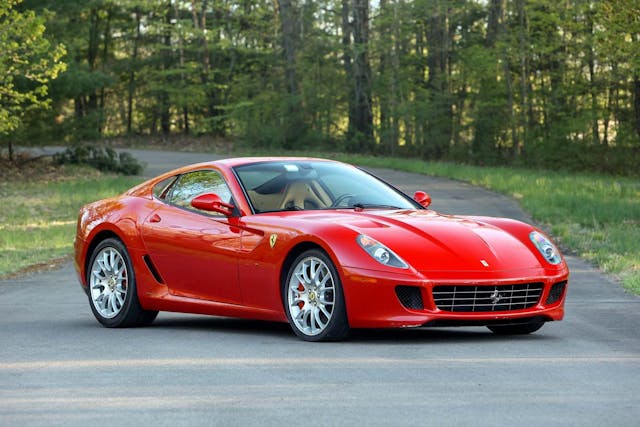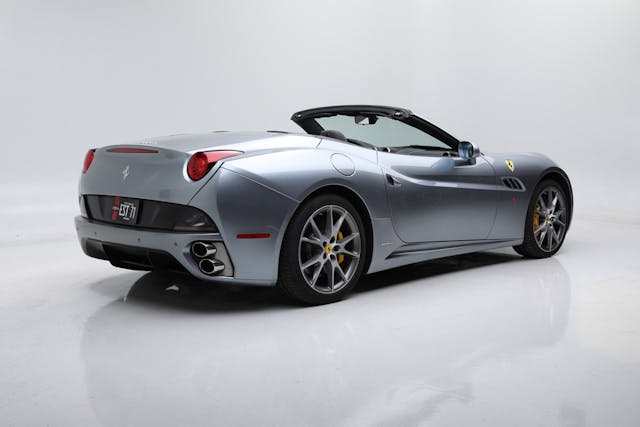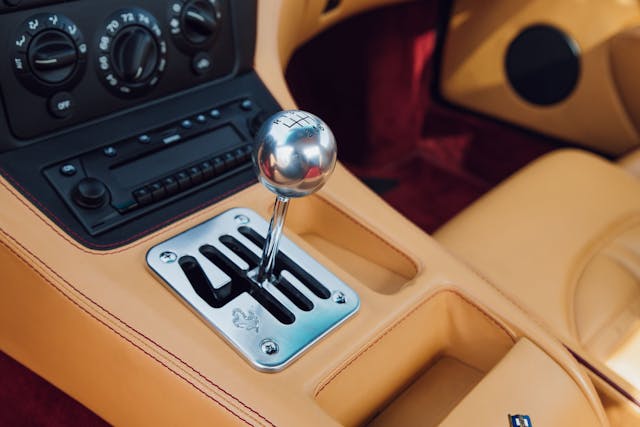Media | Articles
Gated Community: Do converted-manual Ferraris get the same respect?
For decades, the act of driving a Ferrari has always brought with it some expectations. An urgent, glorious sound, usually from a front-mounted V-12 or a V-8 behind the seats. A view over the dashboard that conjured the potential for serious speed. And a manual shifter emerging from that hallmark gate, its distinctive click resonating every time you selected the next gear. Then, about 20 years ago, Ferrari began relegating that last part—the manual transmission—to the dust bin. No surprise, collectors now highly value those last cars with the old-school gearbox, which for so long was integral to the driving experience long associated with the brand.
But is that shifter really why those cars are more valuable? Let’s take a look.
The sunset for manual Ferraris began at the race track. Inspired by the system on its Formula One cars (introduced for the 1989 season), the initial road-going F1 transmission incorporated the same single-clutch setup but used a new interface. It did away with the clutch pedal, open shift gate, and gear lever. In their place were shift paddles behind the steering wheel to select the gear and a computer that managed an actuator for the clutch. Debuting on the 1997 F355, the F1 transmission gained acceptance in the market and eventually became the most popular choice for changing gears.

Cars like the 1999–2005 Ferrari 360, the 2002–2006 Ferrari 575M, the 2005–2011 Ferrari 612 Scaglietti, the 2005–2009 Ferrari F430, the 2007–2011 Ferrari 599 GTB, and the 2009–2014 Ferrari California all featured some mix of manual and F1 transmissions. In some cases, though, like the 599 and the California, less than 1 percent of production had a manual.
The Hagerty Price Guide distinguishes the value of the manual transmission for these models, except for the California. For each, as the F1 transmission becomes more common and the manual transmission increasingly rare, premium for the manual grows.
Marketplace
Buy and sell classics with confidence
Early in the transition, an F355 model with the manual is worth one-third more. On the succeeding 360 model, the manual can be worth one-third to 50 percent more, and for the F430, the rare manual car can be worth twice as much. Among the V-12s, the 575M was the first model to get the F1, and a manual 575M is worth 125 percent more. A manual 612 Scaglietti is not far behind, at 120 percent more. Though the exceptionally rare (30 built) manual-transmission 599 GTB has a price guide note of +$150K (~60 percent), some manual 599s have sold for approximately 250 percent more in the past year. Even fewer Ferrari Californias were built with a manual, but we don’t yet have a pricing note for those in the guide.
Enthusiasts saw the price difference between the two and realized that the cost of converting a car with an F1 transmission to one with an open-gate manual was less than the gap in values. Consequently, more cars are being converted and appearing on the market. But how does the market value those converted cars?
Ten examples of converted cars have sold (most were F430s, but 430 Scuderia and 599 GTB models sold as well) at auction in the past year. Comparing those prices to the Hagerty Price Guide condition-appropriate value (for the F1-equipped cars) at the time of the auction shows a 9.4 percent average discount and a median discount of 5.3 percent. Needless to say, that’s far less than the 100 percent premium for a factory-built manual transmission F430.
For a bit of additional context, manual conversions aren’t unique to Ferraris from this era. BMW’s E46 M3 is not nearly as rare or valuable as a contemporary Ferrari, but it’s still a strong enthusiast choice, and SMG automatic-equipped versions are increasingly the targets of conversion. Of the 15 transactions of manual-swapped E46 M3s for which we have data, the average condition-appropriate difference to a factory-equipped manual transmission car is +2.5 percent. In contrast to Ferrari, the BMW market appears to value the type of transmission rather than where and when it was installed.
Why converted Ferraris don’t get the same prices as factory-built manual transmission cars, or even the prices of the F1 automatic models they once were, could be due to several factors. Perhaps Ferrari collectors value the rarity of a factory-built manual over the driving experience. Certainly, the high prices paid for zero-mile Ferraris support the idea that collecting, rather than driving, is the primary objective. Another consideration is that modifications are unpopular in the Ferrari world.
Where does that leave the converted cars? At the discounted rate they’re selling for, such cars are a great opportunity for Ferrari fans who prioritize driving over static originality. What would you do with a manual-transmission Ferrari?

***
Want a better understanding of what’s driving collector car values? Sign up for the Hagerty Insider newsletter.





What would I do with a manual transmission Ferrari? I’d drive it, original or converted.
I really have zero interest in newer Ferraris, primarily because they abandoned the manual transmission. I’d much rather have a converted car than original F1 or automatic.
my sentiments exactly
As they say, it’s only original once.
I would hope that an astute “converter” would have kept the original transmission in their possession..
Ha! “Converter” – good one!
I would drive the Ferrari, as someone else said, automatic, converted, or original manual. That said, I might prefer the manual, but would probably not be inclined to pay the price premium an original one draws. Manual or automatic, it is STILL A FERRARI!
Again… a gated shifter for a Ferrari is part of what makes the experience. Modern ones are a different beast.
I have a couple of MT-equipped BMW’s today, one a classic and the other not. I also have one with BMW’s dual clutch transmission. Love them all. And with the E46 M3, you can convert to MT using the original transmission if you so choose. But as I approach Medicare age, I guess I don’t care what transmission a Ferrari has. If I can get an F1 at big discount compared to the MT version, then sorry, I don’t need to pay the premium.
Taking a quick look thru BaT results for several ’07 599’s, the only gated conversion sold $256k….$100-125K above the average F1 equipped cars. Conversion costs only going up as factory (OEM) manual parts becoming scarce & labor $ always on the rise. Surprising data would suggest a very modest 4.3% delta Converted vs Factory F1
I loved F1 until the paddles came in and that was it, quit attending and watching. Might as well watch sewing machines race. As my wife says, why would you not want a manual in these beautiful machines?
there is a difference between driving a car where you do the work and maintain control of it as opposed to merely steering it and having computers onboard and lab derived programmes changing gears for you as well as accelerating and even braking;
either you’re driving or being driven;
Ironic that converted F1 or SMG cars bring far less than OE manual transmission models when you consider that the conversions on most of these cars are done using factory parts. As for the E46 SMG BMW M3, my son had one and it was a truly miserable driving experience, as well as being inordinately expensive to repair.
The manual transmission went the way of the art of the Pininfarina car. With the end of the 355, form over substance was over. The new, wind tunnel shaped, stern is sensible, but not beautiful…and the same is to be said for the quick responding, faster, F1 tranny.. But that is not what it is about with Ferraris of the past. I have driven them my entire life. It is a blessing. Horsepower and speed never were the hallmark. It was the art and the experience. The good ones did not leap, but responded precisely to the pedal. Lambos leap. Ferrari engines were jewelry cast. Lambos were sand cast bruts, much faster, but horrible. The era ended with the swan song that was back end of a 355 GTB or GTS.. The 355 backend makes no sense, but it is the most beautiful rear ever put on a car… and the gated shifter, phased out in that moment was the most pure of all Ferrari appointments. If you haven’t heard the high pitched “clink” from beneath your right knee, you have never driven a Ferrari.
The F355 might be the most beautiful, but the XKE Roadster is sexier.
Oh, Hugh, I disagree. While living in the Middle East, in the early ’80s, I was fortunate enough to have a European friend possessed of a 400i, oddly enough equipped with a GM Turbo Hydramatic 400- and the exact same console shifter that came with my ’67 Impala SS! Imo the 400s were far superior 4 seaters over the Mondials, and even with the automatic and factory mufflers it was simply wonderful to drive, such a glorious noise when pressed. I’ve owned many high performance cars in my 63 years, predominantly Pontiac GTO and SS Chevrolet models, with the odd Asian/European tossed in- but that 400i remains the benchmark by which I compare driving experiences. Would it have been more intense with the manual? Certainly more engaging, but I was in my early 20s then, driving someone else’s Ferrari, so both hands on the wheel was likely for the best. I’m going to say that I indeed have driven a Ferrari, just not had the vintage experience. Btw, I agree about the F355, even though overall, for me, I think I like the overall look of the 400s and 308s better, with the 288 GTO at the pinnacle.
I bought a used F1 430 and I did not like the paddles. I thought I would like it but I actually hated it. I had my car converted to a manual for a better driving experience. At the time I could not afford a factory manual, it was $30,000 more than buying an F1 430 then converting it. If I was to do it again I would get a loan for the factory original manual because of the price increase and the car being original. I do enjoy my manual and it shifts the same as a factroy original. The driving experiece is so much than a paddle car. To me driving a paddle shift car is like diving an automatic. My first car was a manual back in the 1970’s and that is the car I learned on. I just feel more confortable driving a manual sports car.